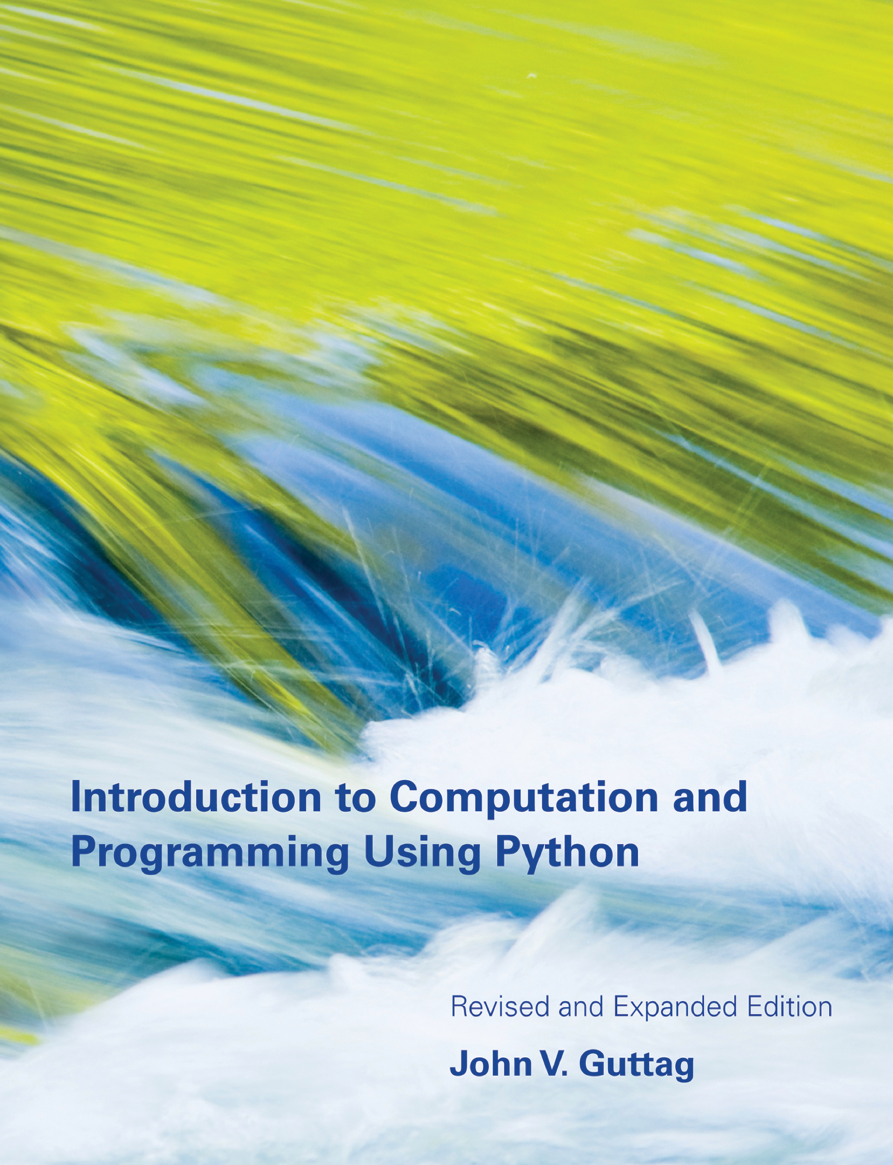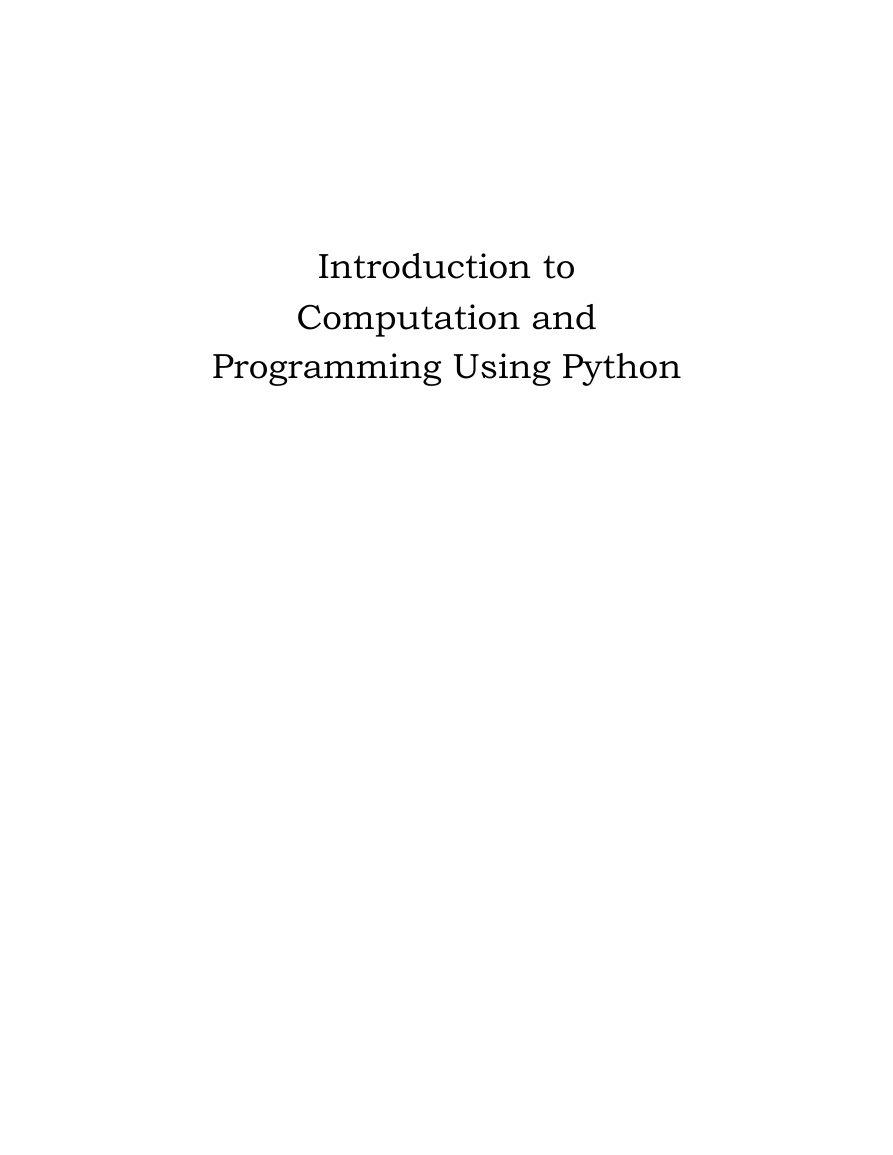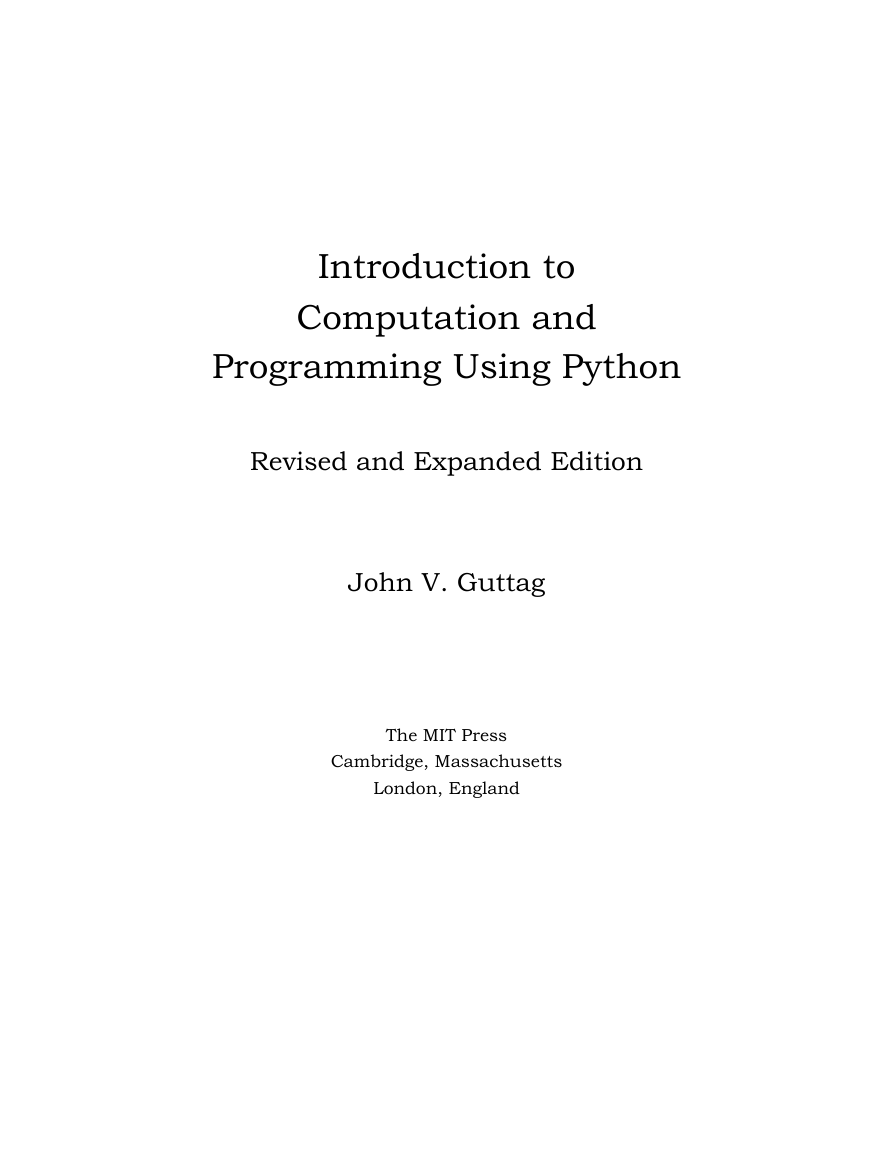Contents
Preface
Acknowledgments
1 Getting Started
2 Introduction to Python
2.1 The Basic Elements of Python
2.2 Branching Programs
2.3 Strings and Input
2.4 Iteration
3 Some Simple Numerical Programs
3.1 Exhaustive Enumeration
3.2 For Loops
3.3 Approximate Solutions and Bisection Search
3.4 A Few Words About Using Floats
3.5 Newton-Raphson
4 Functions, Scoping, and Abstraction
4.1 Functions and Scoping
4.2 Specifications
4.3 Recursion
4.4 Global Variables
4.5 Modules
4.6 Files
5 Structured Types, Mutability, and Higher-Order Functions
5.1 Tuples
5.2 Lists and Mutability
5.3 Functions as Objects
5.4 Strings, Tuples, and Lists
5.5 Dictionaries
6 Testing and Debugging
6.1 Testing
6.2 Debugging
7 Exceptions and Assertions
7.1 Handling Exceptions
7.2 Exceptions as a Control Flow Mechanism
7.3 Assertions
8 Classes and Object-Oriented Programming
8.1 Abstract Data Types and Classes
8.2 Inheritance
8.3 Encapsulation and Information Hiding
8.4 Mortgages, an Extended Example
9 A Simplistic Introduction to Algorithmic Complexity
9.1 Thinking About Computational Complexity
9.2 Asymptotic Notation
9.3 Some Important Complexity Classes
10 Some Simple Algorithms and Data Structures
10.1 Search Algorithms
10.2 Sorting Algorithms
10.3 Hash Tables
11 Plotting and More About Classes
11.1 Plotting Using PyLab
11.2 Plotting Mortgages, an Extended Example
12 Stochastic Programs, Probability, and Statistics
12.1 Stochastic Programs
12.2 Inferential Statistics and Simulation
12.3 Distributions
12.4 How Often Does the Better Team Win?
12.5 Hashing and Collisions
13 Random Walks and More About Data Visualization
13.1 The Drunkard’s Walk
13.2 Biased Random Walks
13.3 Treacherous Fields
14 Monte Carlo Simulation
14.1 Pascal’s Problem
14.2 Pass or Don’t Pass?
14.3 Using Table Lookup to Improve Performance
14.4 Finding π
14.5 Some Closing Remarks About Simulation Models
15 Understanding Experimental Data
15.1 The Behavior of Springs
15.2 The Behavior of Projectiles
15.3 Fitting Exponentially Distributed Data
15.4 When Theory Is Missing
16 Lies, Damned Lies, and Statistics
16.1 Garbage In Garbage Out (GIGO)
16.2 Pictures Can Be Deceiving
16.3 Cum Hoc Ergo Propter Hoc
16.4 Statistical Measures Don’t Tell the Whole Story
16.5 Sampling Bias
16.6 Context Matters
16.7 Beware of Extrapolation
16.8 The Texas Sharpshooter Fallacy
16.9 Percentages Can Confuse
16.10 Just Beware
17 Knapsack and Graph Optimization Problems
17.1 Knapsack Problems
17.2 Graph Optimization Problems
18 Dynamic Programming
18.1 Fibonacci Sequences, Revisited
18.2 Dynamic Programming and the 0/1 Knapsack Problem
18.3 Dynamic Programming and Divide-and-Conquer
19 A Quick Look at Machine Learning
19.1 Feature Vectors
19.2 Distance Metrics
19.3 Clustering
19.4 Types Example and Cluster
19.5 K-means Clustering
19.6 A Contrived Example
19.7 A Less Contrived Example
19.8 Wrapping Up
Python 2.7 Quick Reference
Index
Uploaded by [StormRG]
















 2023年江西萍乡中考道德与法治真题及答案.doc
2023年江西萍乡中考道德与法治真题及答案.doc 2012年重庆南川中考生物真题及答案.doc
2012年重庆南川中考生物真题及答案.doc 2013年江西师范大学地理学综合及文艺理论基础考研真题.doc
2013年江西师范大学地理学综合及文艺理论基础考研真题.doc 2020年四川甘孜小升初语文真题及答案I卷.doc
2020年四川甘孜小升初语文真题及答案I卷.doc 2020年注册岩土工程师专业基础考试真题及答案.doc
2020年注册岩土工程师专业基础考试真题及答案.doc 2023-2024学年福建省厦门市九年级上学期数学月考试题及答案.doc
2023-2024学年福建省厦门市九年级上学期数学月考试题及答案.doc 2021-2022学年辽宁省沈阳市大东区九年级上学期语文期末试题及答案.doc
2021-2022学年辽宁省沈阳市大东区九年级上学期语文期末试题及答案.doc 2022-2023学年北京东城区初三第一学期物理期末试卷及答案.doc
2022-2023学年北京东城区初三第一学期物理期末试卷及答案.doc 2018上半年江西教师资格初中地理学科知识与教学能力真题及答案.doc
2018上半年江西教师资格初中地理学科知识与教学能力真题及答案.doc 2012年河北国家公务员申论考试真题及答案-省级.doc
2012年河北国家公务员申论考试真题及答案-省级.doc 2020-2021学年江苏省扬州市江都区邵樊片九年级上学期数学第一次质量检测试题及答案.doc
2020-2021学年江苏省扬州市江都区邵樊片九年级上学期数学第一次质量检测试题及答案.doc 2022下半年黑龙江教师资格证中学综合素质真题及答案.doc
2022下半年黑龙江教师资格证中学综合素质真题及答案.doc